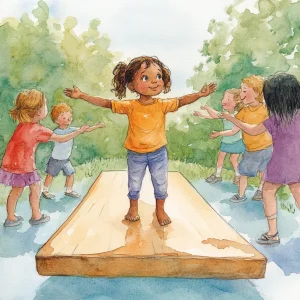Activity
Similar Activities
Empathy through Dance: Expressing Emotions Creatively
Children’s Age: 6–10 years
Activity Duration: 25 minutes
"Empathy through Dance" is an engaging activity tailored for children aged 6 to 10 to foster empathy, moral growth, and language skills. Children will express emotions through move…
Activity Duration: 25 minutes
Engaging Holiday Memory Game for Kids
Children’s Age: 2–6 years
Activity Duration: 10 minutes
Let's play the Holiday Memory Game! You and your child can enjoy this fun activity together without needing any materials. Find a cozy spot, sit down, and get ready to play.
Sta…
Activity Duration: 10 minutes
Enchanted Digital Nature Scavenger Hunt: A Journey Through Technology and Nature
Children’s Age: 12–16 years
Activity Duration: 30 – 40 minutes
The Digital Nature Scavenger Hunt is a engaging activity tailored for children aged 12 to 16, promoting language development, communication skills, empathy, and computer literacy. …
Activity Duration: 30 – 40 minutes
Enchanted Reflections: Peek-a-Boo Mirror Play
Children’s Age: 6 months – 1 year
Activity Duration: 5 minutes
"Peek-a-Boo Mirror Play" is a wonderful activity designed for infants aged 6 to 12 months, focusing on language development and self-awareness. With a handheld mirror and a soft bl…
Activity Duration: 5 minutes
Holiday Emotions Puzzle: Festive Empathy Exploration
Children’s Age: 4–6 years
Activity Duration: 10 – 15 minutes
The "Holiday Emotions Puzzle" activity is designed for children aged 48 to 72 months to develop self-care skills, empathy, and language through logical games and puzzles. Children …
Activity Duration: 10 – 15 minutes
Whispers of the Forest: Nature Sounds Sensory Play
Children’s Age: 6 months – 1.5 years
Activity Duration: 10 minutes
Engage your little one with the "Nature Sounds Sensory Play" activity, perfect for children aged 6 to 18 months. This outdoor adventure promotes language, social-emotional skills, …
Activity Duration: 10 minutes
Adventure Tales: Family Sports Day Storytime Journeys
Children’s Age: 2–3 years
Activity Duration: 10 – 15 minutes
"Family Sports Day Storytime" is a storytelling activity tailored for children aged 24 to 36 months, focusing on language development, communication skills, and family togetherness…
Activity Duration: 10 – 15 minutes
Picnic Adventure: Pretend Cooking Play for Toddlers
Children’s Age: 2–3 years
Activity Duration: 10 – 30 minutes
An imaginative activity where children (ages 2-3) engage in pretend cooking during a picnic adventure.
Activity Duration: 10 – 30 minutes
Balance Beam Adventure: Enhancing Coordination and Focus
Children’s Age: 2–12 years
Activity Duration: 5 minutes
This fun activity called "Balancing Act Fun" is perfect for kids aged 2 to 6. It helps improve coordination, balance, and self-regulation. You'll need a flat surface, a stable boar…
Activity Duration: 5 minutes
Outdoor Tea Party and Fix-it Fun for Toddlers
Children’s Age: 2–4 years
Activity Duration: 10 – 25 minutes
Let's create a fun Outdoor Tea Party and Fix-it Station for kids aged 1 to 3. Set up a table and chairs, play tea set, pretend tools, household items for fixing, a picnic blanket, …
Activity Duration: 10 – 25 minutes
























